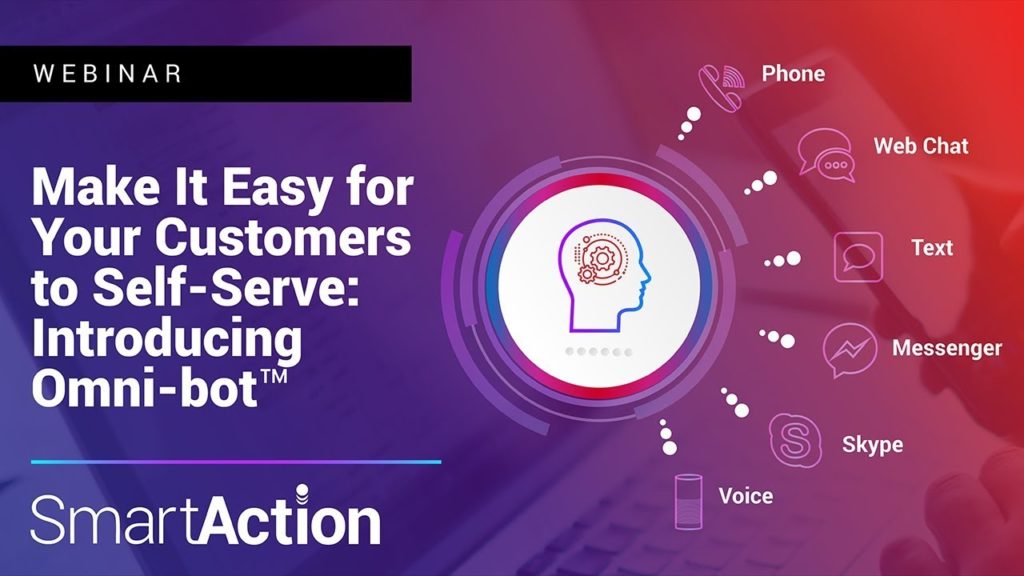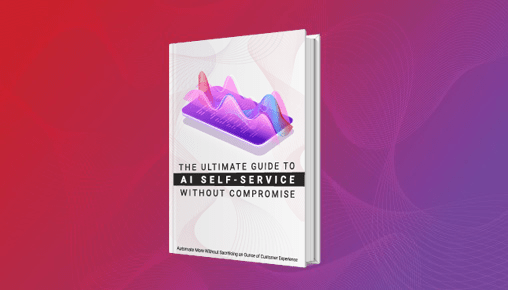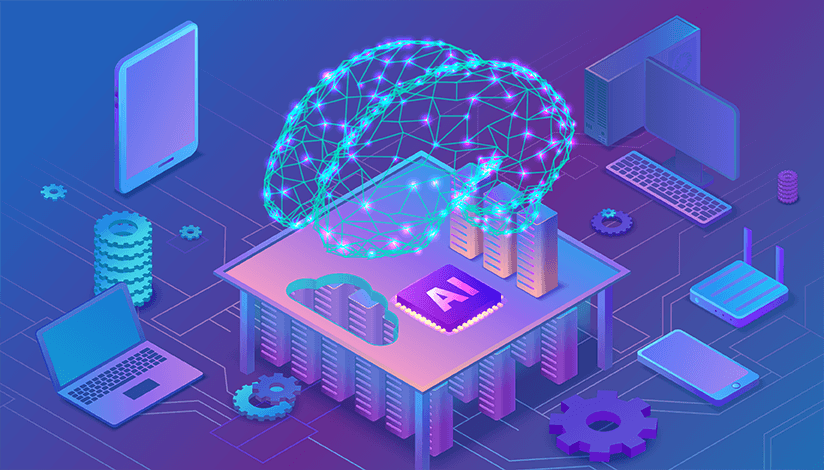Make It Easy for Your Customers to Self-Serve: Introducing Omni-bot™

We’re going to talk a little bit about bringing AI into your contact center, some of the benefits and value adds, and how to simplify your customer service and customer experience.
Watch This
Webinar

Charlie Schrier
Director of Marketing,
SmartAction
Introducing Omni-bot™
Make It Easy for Your Customers to Self-Serve
Kim: Hello, everyone. And welcome to today’s webinar, “Make It Easy for Your Customers to Self-Serve: Introducing Omni-Bot”. We’re going to talk a little bit about bringing AI into your contact center, some of the benefits and value adds, and how to simplify your customer service and customer experience. And so, a couple of things first. We will have a Q&A at the end. You can use that Q&A button any time throughout the presentation and send your questions in, and I will address them to our speaker at the end of the presentation. I am recording this, so I will be sending out a follow-up email by the end of the week with this recording, as well as a couple of additional resources that align with the presentation.
And sorry, again, the presentation will be about 30 minutes but please add your questions anytime throughout and we will go over them at the end. Now, I’m going to introduce our speaker for today. We have Charlie Schrier is going to be presenting for us today. He’s our director of marketing here at SmartAction, and he primarily spends a lot of time with our analyst community. He spends a lot of time talking about customer experience, customer service, and lately a lot more about bringing artificial intelligence into the contact center and the impacts it can have. He’s an expert at identifying the market trends and competitive advantage, and he’s the perfect person to be communicating this message out to you since he spends most of his time talking about it with our analysts. So, over to you, Charlie.
Charlie: Okay, thanks so much, Kim. I’m glad to be talking to everyone today and hopefully this will provide a little bit of insight into your own organizations and what you might be thinking about. So, before we kind of dive in, I want to start by telling a little bit of a story. And hopefully the story will sound familiar within your organization or maybe your own role. It’s probably that your CEO, or your boss, or your manager came to you and said, “I want AI, and I want it now. I don’t really know what it is but it’s your job to go find out how I’m going to get Artificial Intelligence into our business.” You start thinking about it and you kind of think, “Well, I don’t really know exactly what AI is either, so I need to start doing some research, I need to start doing some learning,” and so you start digging around. Specifically, within your customer experience in the contact center, we can kind of look at it in two distinct ways.
This is more of an educational piece and you’ve probably seen the slide if you attended any of our webinars before. And probably in your research, you’ve identified these two different types of Artificial Intelligence that you can use in the contact center. We refer to them as Conversational and Back Office but you’ve probably heard of a lot of different types. Conversational Interfaces is another one, but from the conversational side using AI, it’s a channel based type of technology, voice and digital. So, either in the voice side or maybe in SMS text, web chat, chatbots, that’s really your conversational side and it’s really on the front end directly engaging with customers.
You’ve learned that through your research that there’s a way that you can provide conversational service using AI to your customers directly. You’ve also probably learned that there are ways on the back end that you can provide assistance to your agents to your people, so that you can try and make them a little bit more efficient and you can try and increase the efficiency of your processes as well. But you know that this is an indirect engagement with customers. It’s not actually on the front end, it’s actually something that your agents will probably need to be trained on in different pieces that are helping them become more efficient. So, you know that there’s these two different types of AI in the contact center now.
But you’ve got to decide between which one, where you’re going to really start, what are you going to focus on, what’s going to be most important to you in your own contact center in your own business. So, you kind of look at it in an oversimplified way. Do you want to provide self-service to your customers? Or, do you need an agent assistant on the back end? Here are a couple of stats that might help you make that decision. They’re stats from Gartner, who we subscribe to. Two-thirds of customers want to self-serve, and that number has probably increased. I want to say that this stat might even be a year or two old at this point. The fact that two-thirds of customers want to self-serve means they want to take care of the issues they set themselves. They don’t want to have to talk to people and they prefer when the technology and the self-service works to the point that they can do it themselves.
The second piece of information is that by 2020, which as a reminder, is only about 18 months away, 85 percent of the customer experience will be managed without a human. Your customers will be using self-service and they will be solving their own issues. They will be carrying out most of the customer experience without actually engaging with your people. How can you maximize that for your customers and how can you provide great ways that your customers can self-serve? So, let’s talk about that self-service piece. Let’s talk about how you can get to 2020 and allow 85 percent of your experience to be managed without the human. If we’re talking about self-service and if we’re talking about conversational AI, there’s a lot of noise in the market. That’s probably another thing that you have learned in your journey to figure out ways to bring AI into your contact center. There are difficult decisions to make, specifically around how you’re going to introduce it and how you’re going to bring it into your contact center.
There are two approaches. We’re going with the rule of two in this webinar, and using a lot of different “either-this-or-that” type of situations. The way that we like to think about it and the way that you’ve probably determined in your search that there are kind of two ways. There’s the “Do-It-Yourself,” which is when you purchase access to a platform that allows you to use a NLP engine on the back end, and you’re building out the customer experience, the different journeys, the different pathways that your customers will go down (or yourself). That’s the DIY approach using a platform. Another possibility, or another model, that you’ve probably seen from a variety of different AI vendors is that there’s the service model. They have incredibly advanced training models that use machine learning, deep neural nets, and all kinds of other AI buzzwords that allow the technology to become customized to your business and to the things that you need. They require pretty extensive builds, pretty extensive times, and a lot of data. You need a lot of data, you need a lot of recordings, and a lot of scripts to be able to train those models.
Those are the things that you’ve probably seen out there in the market. One of the things that you might be thinking is that both of those sound like a lot of work. They sound like they may take time, you probably need people, and you need expertise. They sound like they are a lot of work. So, even after you’ve made this difficult decision, you have a difficult road ahead. Not to mention the fact that once you’ve gone ahead with a vendor in one channel, do you need to go find another vendor for another channel? Do you need to go find the new technology for the next channel?
For example, if you decide you want to go down the path of conversational AI and self-service for the phone channel, and you go through one of those models and it takes a certain amount of time and effort, are you then going to have to go do the same thing in chat, text, and social? And some of those other voice interfaces? It can end up being a lot of effort to train those different engines and provide that ongoing tuning. It makes a complex call center environment even more complex by going through these different channels, different vendors, and different experiences.
With all of these challenges that you’ve been facing and looking at how to get AI into your contact center to the places that make the most sense, and how you can be nimble in doing so, you’ve probably come to the conclusion that you need a plan. In trying to help you formulate that plan, let’s take a step back and talk about some other interesting pieces of information and research that’s out there. How can you formulate this plan? What should you really focus on? And what should be important as you evaluate and in creating this plan?
Definitely, one of the things that we subscribe to here at SmartAction is that effort matters, and that the more you can reduce effort for customers, the more success you’re going to find in your customer experience. By reducing efforts for customers, studies have shown that customers are more loyal. It’s a higher predictor of increased spending than customer satisfaction score and net promoter score. While those other scores are very important and probably tell a story of a lot of different types of things, by reducing effort and making it as easy as possible for customers to engage with you, that is the highest predictor of them remaining loyal to your business.
Here at SmartAction, we want our customers to have easy experiences working with us because we know how much effort matters. We know how many other things are going on in the world, and how many different directions people can get pulled in. Taking that approach into your own business and understanding how important that effort is, is really important.
If we take a look back at those different models, as well around the difficult decisions you need to make, let’s break it down a little bit more. From the DIY perspective, as we were talking about, that’s where you’re gaining access to an NLP engine and you’re working off of a platform to build out the customer experience yourself and bring it internally, that’s going to require all three of the things that you see on the right-hand side there. It’s going to require people, it’s going to require time, and it’s going to require money. Those are resources that, maybe you have one but you don’t have the other two, and they can become scarce very quickly.
From a people perspective, you have to think about not just hiring folks to build, but also to maintain, and to keep the experience the best that it can be so that you’re not setting and forgetting the application. You’re continuously tuning it and using machine learning capabilities to your advantage. But even just the build itself can take a lot of time. Not to mention the fact that you need to actually go through a hiring process, bring people on board, do the training, and then they’ve got to get started. There are definitely several pieces to that calendar. Then, obviously, the money…and when we think about it, the platforms generally are not charging a huge amount but the total cost of ownership, from ongoing tuning to paying for the resources and the capabilities, that’s really where you’re going to see the huge investment.
If you’re looking at the service model where we were talking about providing data that trains huge models and becomes customized to your business, those models just take time. If you’re looking to be able to make an impact in a shorter time frame, or at least to do it in a low-risk way, keep in mind those could take somewhere between six and eight months, maybe up to a year, to be able to train those models and gather enough data to actually provide value. And, obviously, the money comes into play as well. How much investment are you willing to make for something that may take that amount of time you may not be seeing ROI? So, you’re starting to notice that this is eventually going to provide an effortless experience for your customers, and that’s what you want. But it’s not that effortless for you. And as you’re thinking about these things, you want to make sure that you’re doing it in a low-risk and somewhat effortless way so that you can really start to provide value quickly for your business.
Okay, so we were talking about how you need a plan. So, let’s re-evaluate that plan based on some of the things that we were just talking about. You need a better self-service option, as with conversational AI, and you’re looking for better self-service because of the way that customers are choosing to engage with you. You need it to meet these criteria. So, easy to implement, as we were talking about just now with the different models. You want it to be something that you can bring into your contact center easily and in a low-risk way, which falls under cost-effective.
Obviously, you want to make a positive impact on your overall customer experience. That’s going to be true for anything that you’re looking at in the contact center but it’s a must-have, it’s one of those things where if it wasn’t on there then it, you know, you’d kind of be scratching your head. You have to have that as well. You want to reduce effort and boosting loyalty. So, how are you reducing effort for customers and making it easy for them to engage with you, making it easy for them to get their thing done? And then lastly, omnichannel. You don’t want those disparate AI deployments in your contact center creating complexity and creating different experiences. You need it to be an omnichannel experience that, as I mentioned, is cost effective.
This is really why we built the Omni-Bot and that’s what the webinar is on: introducing the Omni-Bot and the model by which we’re actually delivering this conversational AI for self-service in your contact center. The approach, what we like to call it, is a build once, deploy everywhere. You get to use one vendor to be able to build one of those experiences and one of those applications in a low-risk way. Then, you’re able to easily deploy it in those other channels that are listed up there. When we were founded, we were primarily a voice company. As we were moving forward with some of our prospects and clients, we heard that they wanted to be able to go into omnichannel ways without having to do those disparate AI deployments. We really have built our business around the effortless experience. So, we want to make it easier for you and we want to be able to deliver those easy experiences to your customers, reducing effort in a dual way, both for you and for your customers.
So, what we’re doing is we’re delivering conversational AI in every channel. And we’re able to do that by delivering a number of benefits which we’ll go over in just a couple of slides. Before we do that, I wanted to talk a little bit about some of the success we’ve had so that you can really put it into perspective how some innovative companies are already using the Omni-Bot today. First of all, we are working with a shipping and logistics company, a truck rental company, to do outbound reminders. They first went live in voice and saw that their customers were moving more towards SMS text channel.
We were able to create that same experience, the same application, in the SMS text channel. We’re doing outbound reminders to make sure that customers are going to show up for their truck. Obviously, when someone doesn’t show or cancels at the last minute, it can actually cause kind of a chain reaction within that business. You might think not showing for a truck only affects you, but really it affects other branches, even just around that region, because they may be expecting your truck to show up somewhere and someone else has that reserve. So, by confirming those, they were able to reduce no shows and increase the number of confirmations and cancellations that were coming through, in order to make their business far more efficient.
From a subscription service perspective, we are actually live with an intelligent front door and authentication piece, which is right on the front end of every single call and web chat that comes into the business. We are identifying who the people are and who the subscribers are that are coming into the channel and what they need to do. There’s even self-service built in beyond that, and those things are live in both voice channel and web chat. It’s the same experience, it’s the same ability to get from the self-service to an agent in a very seamless way. Those deployments have actually saved the retail company over a million dollars in just about a one-year pilot period. So, we’ve definitely found a lot of success there.
Finally, from a billing perspective, in the insurance industry, specifically life insurance, margins can be a really important piece of what they’re doing. They needed a really low-risk way to be able to deliver the omnichannel experience. Not to mention, when their insured customers would lapse on a payment or miss a payment for some reason, whatever that might be (maybe they moved and didn’t receive the letter or maybe it just slipped their mind, or their credit card got changed), if their payment lapsed, so did their coverage. And they would need to go through a long and extensive process to get covered again and to be reinsured. It’s not quite so simple as just hitting the reset button.
This was causing challenges for both customers and for the business. So, they deployed both a voice capability and a SMS text that’s an outbound SMS text of which they’re getting more and more opt-ins on a month over month basis. This has really helped to reduce the number of lapsed payments and they’re gathering more and more data every day on how that’s impacting the bottom line and impacting their margins, allowing them to become a little bit more efficient. I know I kind of drained that slide there but I wanted to really give an understanding of some of the true business problems that we’re helping customers solve and some of the true challenges that their customers are really facing. We are trying to make it as easy and as consistent and as seamless as possible when working with the self-service applications.
Here are some of the unique benefits. I’m not going to drain this slide, mostly because I drained the last one. One of the things that I really just want to focus on is how we’re focused on creating effortless experiences. We’ll start with the experiences that you have with your customers today and we’ll try and make them as effortless as possible, specifically by allowing them to use the channel of their choice. If for some reason they need to talk to an agent or want to talk to an agent, we try and make that pass as seamless as possible providing all of the data from the self-service applications that we’re working on to those agents so that they can pick up conversations right where they left off.
As you know, loyal customers that stick around for a long time have a higher lifetime value. And if that’s something you’re focused on, in terms of building customer lifetime value, you want more loyal customers. That’s one of big things we’ve actually shown to reduce customer effort by 50 percent, cutting certain handle times in half, making processes far more efficient, and allowing customers to do the things that they need to do in a very easy and simple way using the self-service. Those are some of the things around Omni-Bot, our newest release. We’ve seen some great successes there. And, so, I want to thank everyone for joining. And I’m going to pass it back over to Kim and I think we have some Q&A.
Kim: Yes, we do. Thank you, Charlie. We did have a question of something that’s been coming up a lot more lately, regarding some of the larger companies out there that are doing some self-service options. The question is, “With IBM Watson and Amazon Lex, why would I choose SmartAction?”
Charlie: Right.
Kim: Great question.
Charlie: Yeah, it’s a good question. It’s definitely something that we’re seeing more and more. As the big-name players are out there talking about how they have conversational AI, one of the things that we’ve heard is that we’re really the low-risk opportunity for customers. With some of the larger players, they have both models where they have the service model or they’ll have the platform model. What we found is that a lot of times, those can end up costing a lot of money and taking a long time. What ultimately happens is there’s some exhaustion around actually delivering the product. The plan doesn’t ever get carried out as it should have been and it gets abandoned at some point.
So, if you want to make sure that you’re following through and going with a low-risk and low-effort implementation, our implementation approach is a lot more focused on being able to iterate and expand and improve. We will focus on where the most ROI is for you to get started, we’ll prove that ROI case, and then we’ll move into other self-service options that really start to push the boundaries of complexity and allow your agent population to super focus on the things that are most important. For example, the highest value customers and the things that they really should be focused on, like providing empathy, or upselling, and doing those human things that AI just isn’t quite there yet on.
Kim: Okay, thank you. We have another question about the Omni-Bot solution. So basically, who on my team needs to be involved, what internal resources are involved on my side, and who’s actually managing it? And how do we know it’s working? It was a lot.
Charlie: Yeah. Those are all good questions. From the resources side, the one thing I did touch on in the challenge but maybe not in the solution was that SmartAction works in more of a SaaS model. It’s a service and it’s not just software that we set and forget. Our team manages the solution and provides those updates, provides those enhancements and improvements on an ongoing basis. Regularly, we are providing valuable insights and always improving the natural language capabilities throughout the lifetime of the application. As long as you’re working with us, we’re always improving the application and finding ways for it to get better.
I think that covers off on the resources. From your side, it’s primarily a project manager, someone to help with integrations, and a business lead who understands the impacts around the entire business and what some of those initiatives are. That’s really it. We provide most of the value in terms of the resources. How do you know it’s working? We use a web portal where you can log in and find all the statistics from all of your applications and find all the recordings from calls and web chats. Not to mention we do quarterly business reviews to ensure that all is going well and that we’re identifying opportunities to truly improve the core application as well as any supplemental applications.
Kim: All right. Okay, we did get a question through the chat screen. And Charlie, I don’t know if this is something that you’ll be able to elaborate on. The question is asking about internal helpdesk space. So, assisting, taking the burden off of internal analysts for first line tasks such as password reset, unlock, further internal system account unlocks, I don’t know if you can address that.
Charlie: Hopefully I’m going to answer it as a kind of a tech support question. If I don’t totally answer the question, then please reach out because I’d like to make sure I answer it exactly. What I think you’re asking is are we able to handle some of those first line of defense questions around tech support, possibly for internal purposes but I’ll also answer it for external purposes. And we do. We’re actually working on an application today and we have had customers before who have done tech support from a first line of defense. Some of those repetitive but somewhat low value add support questions from a tech perspective. We have handled a few of those specifically around password reset, Wi-Fi, modem reset, and some of the other kind of first line of defense that you might be getting. Hopefully that answers your question. Short answer being yes and there’s probably a longer answer in there that I’d be glad to jump in and answer with you possibly after the webinar is over.
Kim: Yeah, and actually to that note too, if you do have questions that haven’t been answered or you have questions that come up afterwards, feel free to reply to the email. Any of the invitation or auto-reply emails that have come back with the webinar information, or even the follow-up emails, come directly to me. My name is Kim, by the way. You’ll see Kimberly Snow on the email “from” line. Reply back to that and it will come to me, and I’ll make sure to get those questions to Charlie.
That was the last question for today’s presentation. Look for a follow-up email with the recording of the webinar and a couple of additional resources. Reply back if you have questions or if you want me to connect you with Charlie directly. I’ll take care of that for you. Outside of that, thank you all for attending and we’ll see you at or hear you at next month’s webinar. Thank you.





